Drama 作者: 来源: 发布时间:2021-07-12
I.Population and Area
Location within the region
Coordinates: 41°9′N 24°8′E
Area
• Municipality 840.1 km2 (324.4 sq mi)
• Municipal unit 488.8 km2 (188.7 sq mi)
Elevation 115 m (377 ft)
Population (2011)
• Municipality 58,944
• Municipality density 70/km2 (180/sq mi)
• Municipal unit 58,532
• Municipal unit density 120/km2 (310/sq mi)
Community
• Population 44.823 (2011)
Time zone UTC+2 (EET)
• Summer (DST) UTC+3 (EEST)
Postal code 661 00
Area code(s) 25210
Vehicle registration ΡΜ
Drama is a city and municipality in northeastern Greece in Macedonia. Drama is the capital of the regional unit of Drama which is part of the East Macedonia and Thrace region. The city (pop. 44,823 in 2011) is the economic center of the municipality (pop. 58,944), which in turn comprises 60 percent of the regional unit's population. The next largest communities in the municipality are Choristi (pop. 2,725), Χiropótamos (2,554), Kallífytos (1,282), Kalós Agrós (1,178), and Koudoúnia (996).
Built at the foot of mount Falakro, in a verdant area with abundant water sources, Drama has been an integral part of the Hellenic world since the classical era; under the Byzantine Empire, Drama was a fortified city with a castle and rose to great prosperity under the Komnenoi as a commercial and military junction.
In the modern era, tobacco production and trade, the operation of the railway (1895) and improvement of the road network towards the port of Kavala, led to an increase in the population of the city and to the enhancement of commercial activity.
Drama hosts the "Eleftheria", cultural events in commemoration of the city's liberation, at the end of June or beginning of July, and an annual film festival in September.
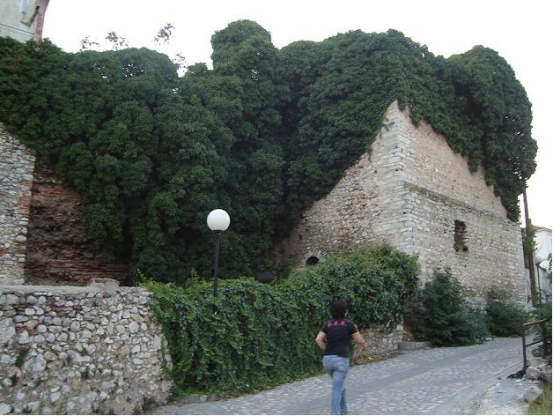
II.Natural Geography (environment and resources)
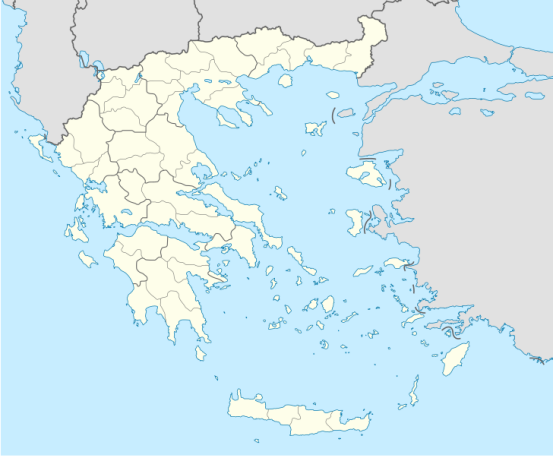
III.Economy
Drama - Euro per inhabitant
10,700.00
in 2011
Drama euro per inhabitant was at level of 10,700 in 2011, down from 11,400 previous year, this is a change of 6.14%.
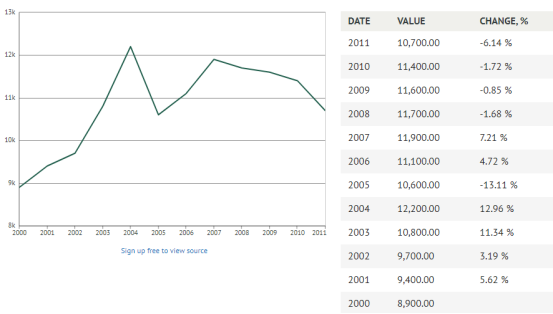
Drama - Purchasing Power Standard per inhabitant
11,600.00
in 2011
Drama purchasing power standard per inhabitant was at level of 11,600 in 2011, down from 12,400 previous year, this is a change of 6.45%.
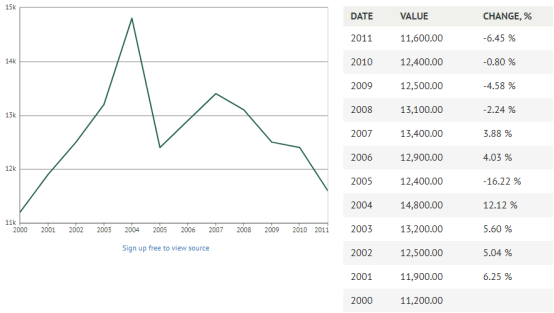
Reference:https://knoema.com/search?query=Drama%2C%20economy
IV.Industrial Characterisitics
In the recent past the economy of the Drama area relied heavily on the local paper and textile-clothing industries. However, these industries have either closed down or moved across the border to Bulgaria, because of the low demands of the Bulgarian workforce, with a negative impact on the local economy and employment. The situation worsened after 2007, when Bulgaria was admitted to the EU, and local Greek businessmen moved to expand their operations there. Other sources of revenue include agriculture, consisting mainly of tobacco plantations, small-scale mining (particularly of marble) and forestry. Recently, there have been efforts to exploit the rich local natural environment and to develop ecotourism.
There is a modern ski resort on Mount Falakro. Drama also hosts an annual short film festival.
Tenders - Announcements
1, INVITATION FOR EXPRESSIONS OF INTEREST FOR SUPPLY OF MICROBIOCIDE FOR BONE DISINFECTION
https://dimos-dramas.gr/wp-content/uploads/2020/09/23883-%CE%9C%CE%99%CE%9A%CE%A1%CE%9F%CE%92%CE%99%CE%9F%CE%9A%CE%A4%CE%9F%CE%9D%CE%9F-%CE%A3%CE%9A%CE%95%CE%A5%CE%91%CE%A3%CE%9C%CE%91-%CE%91%CE%A0%CE%9F%CE%9B%CE%A5%CE%9C%CE%91%CE%9D%CE%A3%CE%97%CE%A3-%CE%9F%CE%A3%CE%A4%CE%A9%CE%9D.pdf
2, INVITATION FOR EXPRESSIONS OF INTEREST FOR SUPPLY OF ELEVATOR SPARE PARTS WITH THEIR INSTALLATION
https://dimos-dramas.gr/wp-content/uploads/2020/09/23891-%CE%91%CE%9D%CE%A4%CE%91%CE%9B%CE%9B%CE%91%CE%9A%CE%A4%CE%99%CE%9A%CE%91-%CE%91%CE%9D%CE%95%CE%9B%CE%9A%CE%A5%CE%A3%CE%A4%CE%97%CE%A1%CE%91.pdf
3,ANNOUNCEMENT OF TENDER WITH OPEN PROCEDURE FOR THE ASSIGNMENT OF THE WORK "Snow-defrosting of the area of the Municipality of Drama for the winter period November 2020 - April 2021"
The Mayor of Drama announces the open procedure for the selection of a contractor for the execution of the work: "Snow-defrosting of the area of the Municipality of Drama for the winter period November 2020 - April 2021", Estimated value 46800,00 Euros (plus VAT)
DECLARATION: https://dimos-dramas.gr/wp-content/uploads/2020/09/%CE%9A%CE%97%CE%9C%CE%94%CE%97%CE%A3-%CE%94%CE%99%CE%91%CE%9A%CE%97%CE%A1%CE%A5%CE%9E%CE%97.pdf
DECLARATION SUMMARY:
https://dimos-dramas.gr/wp-content/uploads/2020/09/%CE%9A%CE%97%CE%9C%CE%94%CE%97%CE%A3-%CE%A0%CE%95%CE%A1%CE%99%CE%9B%CE%97%CE%A8%CE%97-%CE%94%CE%99%CE%91%CE%9A%CE%97%CE%A1%CE%A5%CE%9E%CE%97%CE%A3.pdf
4,INVITATION FOR EXPRESSIONS OF INTEREST FOR SUPPLY OF UNIFORM POLICE SPECIAL UNIFORM PERSONNEL
https://dimos-dramas.gr/wp-content/uploads/2020/09/23683-%CE%A0%CE%A1%CE%9F%CE%A3%CE%9A%CE%9B%CE%97%CE%A3%CE%97-%CE%95%CE%9A%CE%94%CE%97%CE%9B%CE%A9%CE%A3%CE%97%CE%A3-%CE%95%CE%9D%CE%94%CE%99%CE%91%CE%A6%CE%95%CE%A1%CE%9F%CE%9D%CE%A4%CE%9F%CE%A3.pdf
5, ANNOUNCEMENT OF TENDER FOR THE PROJECT "DEVELOPMENT OF A DIGITAL CULTURAL IDENTITY SYSTEM OF THE MUNICIPALITY OF DRAMA"
The Mayor of Drama declares
The open procedure selection of a contractor for the execution of the above work "Development of" Digital System of Cultural Identity "MUNICIPALITY OF DRAMA"
Estimated value 318,548.39 euros (excluding VAT)
Reference: https://dimos-dramas.gr/
V.Attractions
1, Oneiroúpoli
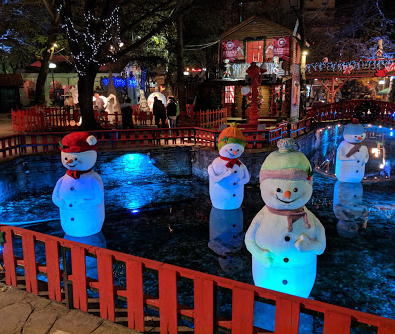
"Nice place especially on Christmas period."
Located in: Municipal Garden
Address: Drama 661 00, Greece
Phone: +30 2521 070097
2, Archaeological Museum
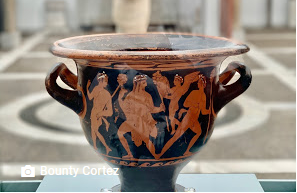
The Archaeological Museum of Drama is located in the city of Drama in East Macedonia and Thrace, Greece. It was built by the Municipality of Drama and inaugurated on 12 December 1999.
The exhibits record the cultural history of Drama prefecture from the Middle Palaeolithic to 1914. The oldest finds (bones and stone tools) come from excavations in the cave at the source of the River Angitis (50,000 BC), and the museum also displays tools, jewellery, and pots from the prehistoric settlements of Sitagra and Arkadikos (6000–4000 BC) from the Early Bronze Age (many of the pots), the Late Bronze Age (finds from graves at Potami and Exohi), and from the Early Iron Age (pots, weapons, tools, and jewellery from graves in the industrial area of Drama).
The museum also has examples of Attic pottery (6th and 5th century BC), a marble bust of Dionysos, which constitutes the earliest evidence of his cult in the wider area, a hoard of coins of Philip II from an excavation at Potami, and other finds from the ancient settlement of Drama (4th century BC). Most of the finds from the Roman period come from the city of Philippi (such as the bronze statuette of Zeus), though some are from other areas (such as the grave stela of Tiberius Claudius Maximus, which was found at Grammeni).
The Early Christian period in the area is represented by coins and pottery from the settlement at Drama and from Philippi. The most characteristic of the few monuments of the Byzantine period are a stone sundial with engraved hours (1069 ad) from the Palaiohori area, and pottery, coins, and jewellery from Drama, Adriani, and Ksiropotamos.
The museum also displays a hoard of Ottoman coins, icons and architectural members from post-Byzantine churches, and a number of photographs of Drama and the surrounding area prior to liberation in 1913. Sculptures (votive monuments, architectural members, and grave monuments) from the ancient period to the time of Ottoman rule are displayed in the covered atrium.
3, Municipal Garden
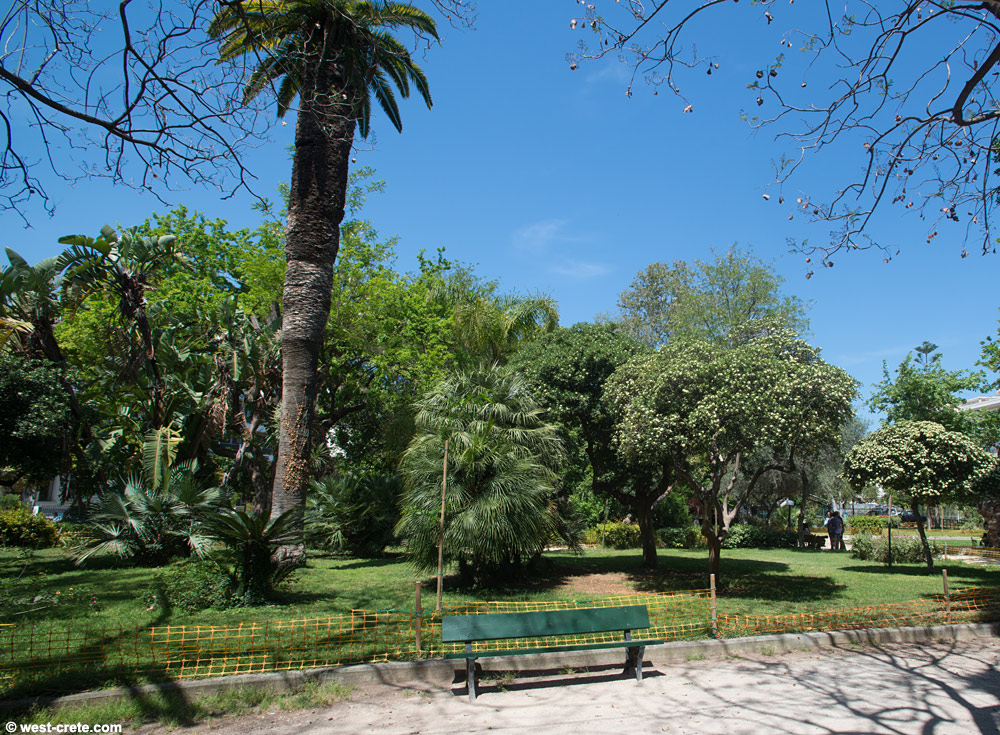
"Interesting decoration, events and the train that gives you a ride into the city worths a ride."
4, Warehouse Portokaloglou
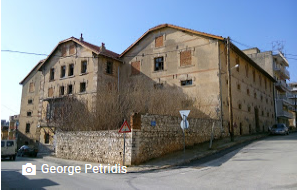
Historical Landmark
VI.History
The city was originally named Ydrama or Dyrama (Ύδραμα, Δύραμα) by the ancient Greeks owing to its abundant water. Later known as Drabescus, it was part of the Roman and Byzantine Empires along with the rest of Greece. The region was conquered by Ottoman Empire in 1371. In the 19th century, the town became centre of the Sanjak of Drama. In 1912 during the First Balkan War, Drama was taken from the Ottomans by Bulgarian troops. Subsequently, in 1913 as a result of the Treaty of Bucharest, following the Second Balkan War, it was incorporated into Greece along with the rest of eastern Macedonia.
World War II
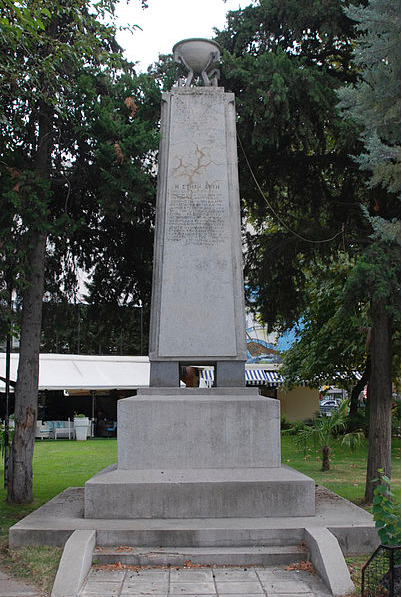
Monument for the Drama uprising
Drama was occupied by Bulgarian troops in the wake of the German invasion of Greece, from 1941 to 1944 during World War II.
On 29 September 1941, in response to local communist guerrilla attacks against the Bulgarians in the villages of Drama, the Bulgarian occupation forces applied harsh reprisals in Drama, Doxato and several villages like Choristi, Kyrgia, Koudounia and Prosotsani.
On 4 March 1943, after midnight, the Bulgarian military authorities rounded up the Jewish population across their zone of occupation in eastern Macedonia and Thrace. The 4,000-strong community, including 589 Jews from Drama, was carried by train into Bulgarian territory and assembled in the tobacco warehouses, which were empty at that time of year. From there, they were taken by train to the Treblinka extermination camp. None of the 589 Jews from Drama ever returned.
VII.Other information
Culture
Since 1978, Drama hosts Drama International Short Film Festival. In 1987, the festival was recognized nationally. In 1995, it added the International competition section where short films from all over the world visiting the city every year. In 1996, the festival was included in the National Cultural Network of Cities by the Greek Ministry of Culture.
Museums
Archaeological Museum
Main article: Archaeological Museum of Drama
The Archaeological Museum of Drama covers human presence in the regional unit of Drama from the mid Paleolithic Period (50,000 years before present) with traces of life from Paleolithic hunts in the caves of the source of the Angitis, up to modern times (1913).
The exhibition space consists of three main halls. In the first archaeological finds from the cave of Maara give witness to the presence of nomadic hunters in the area from the mid Palaeolithic period, while other finds show us about the life of settled farmers and animal rearers from Neolithic villages and the passage of the Copper Age in the city of Drama and the village of Sitagri. The reproduction of a Neolithic house with finds which describe the activities of Neolithic man and his daily activities is the main centre of interest for visitors of all ages.
Bust of Dionysius, found in the area of Kali Vrysi. The same hall continues the journey through time to the Iron Age and later years where the main element was the worship of Dionysius at the city of Drama itself and at Kali Vrysi and other areas of the regional unit. In the second hall architectural sculptures, pottery and coins confirm that life continued in the city and throughout the whole regional unit during early Christian, Byzantine and post-Byzantine years.
The visitor is taken through modem recent history by a photographic exhibition relating to the city of Drama, the towns of the regional unit and the mountain villages. The exhibition covers the period from the beginning of Ottoman period up to the middle of the 19th century. In the third hall which is roofed with an atrium, the visitor can admire sculptures arranged into three thematic groups. The first includes architectural sculptures dating from ancient times up to Turkish occupation. The second contains votive monuments connected with the worship of various gods in the Greco-Roman pantheon as well as local deities, with particular reference to Dionysius while the third group of sculptures focuses on funerary monuments from Hellenistic and Roman times.
Ecclesiastical Museum
The history of the Christian Church in Drama began during the Byzantine period and underwent difficult and troubled times. From the 14th century when the city was captured by the Ottomans until the 20th century with successive foreign occupations, the Greek Orthodox Church in Drama struggled without end, fed by the blood of many faithful, martyrs to the faith and to the Hellenic ideal and provided succor to its followers through difficult periods.
The collection of icons dating from Byzantine times to the 20th century forms the basic core of the museum's exhibits. The Museum of the Cathedral of Drama, founded during the reign of the honourable Bishop Dionysius 1st, is now housed in a recently restored five-storey wing of the Bishop of Drama's palace on Venizelou St. In the spacious and well-attended halls, ecclesiastical treasures of priceless spiritual and artistic value are on exhibition. The Icons of the Virgin Ηοdegetria and the Blessing Lord from the 13th century, icons from the 17th century and particularly from the 19th century decorate and sanctify the place. Moreover, the episcopal canonicals, holy vessels and their covers, many from the 19th century, relics of Chrysostomos of Drama and Smyrni, constitute the most important exhibits in the museum.
Many of the exhibits are relics brought by refugees from Asia Minor and Pontus in 1922 from the churches of their ancient homes to their new home, valuable reminders of who they were and where they came from. Organized groups of pilgrims and visitors to the city are advised to contact the office of the Diocese of Drama before visiting the museum to make arrangements.
Other museums
Folklore Museum (Drama)
Sport
Drama hosts many sport teams in various sports. The most famous and most popular is Doxa Dramas, founded in 1918. Other successful clubs with presence in Greek national divisions are KAOD (basketball club), Pandramaikos FC, Drama 1986 and Amazones Dramas.
VIII.Contact information
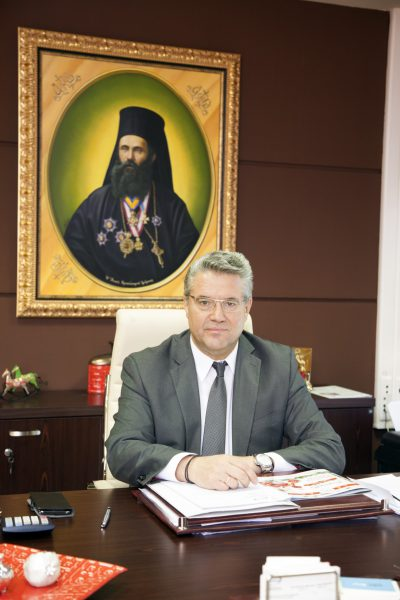
Mayor: Christodoulos Mamsakos
Christodoulos Mamsakos was born in 1964 in Drama, is married to Roubini Kouranou and father of two children, Theodora and Evangelos.
He is a graduate accountant-tax consultant and holds a Master of Business Administration (MBA). He has a long professional experience in companies of any type and legal form on the wider region and a rich educational experience as seminars rapporteur in accounting, taxation and human resources.
In 2014 he was elected Mayor of Municipality of Drama with the municipal faction “Enonoume ti Drama”, which he is leading. He is Chairman of DI.A.A.MA.TH. A.A.E. (Development SA Waste Management Company of Eastern Macedonia – Thrace), Chairman of D.E.P.AN. (Greek Cities Network for Development), Manager of KEDE in Greek-German Assembly, Vice President of Strategic Transboundary Cooperation «Nestos – Mesta» of the Community Initiative INTERREG III for the Euroregion Nestos – Mesta, Member of the Commission for Planning, Infrastructure and Environment of KEDE (2014 – 2019), Member of the City Council of Greek Martyr Cities Network, CEO of the Development of Drama SA – Development SA O.T.A. and President of the Schools’ Boards Committees in the Municipality of Drama.
He was President of D.E.Y.A.D. (Municipal Water Works and Sewerage of Municipality of Drama), Vice President of the Municipal Committee of Drama, Alderman for Technical Services and head of the Office on Planning and European Programmes of Municipality of Drama, Vice President of Awareness & Prevention Center of Municipality of Drama, Special Representative Adviser for Municipality of Drama in European Programmes issues, Board Member of the Municipal Vocational Training (KEK of Municipality of Drama), Chairman of the Legal Entity K.A.P.I. in Xoristi Dramas, Nursery Chairman in Xoristi Dramas, President of the Local Council in Xoristi Dramas, Representative of the City of Drama for cooperation with the Chamber of Drama to develop programs and initiatives.
MUNICIPALITY OF DRAMA:
Email: info@dimosdramas.gr
Fax of the Municipality of Drama: 2521020000
Call center: 2521350600
Address: Vermiou 2 & 1st of July - Post Code 66100 - Drama
https://dimos-dramas.gr/
Social Media:
Facebook: Visit Drama @DramaTourismDepartment
Youtube: https://www.youtube.com/channel/UCDS4IVy4Jg_t_pO8T85Tv6w
Twitter: Visit Drama @VisitDrama
